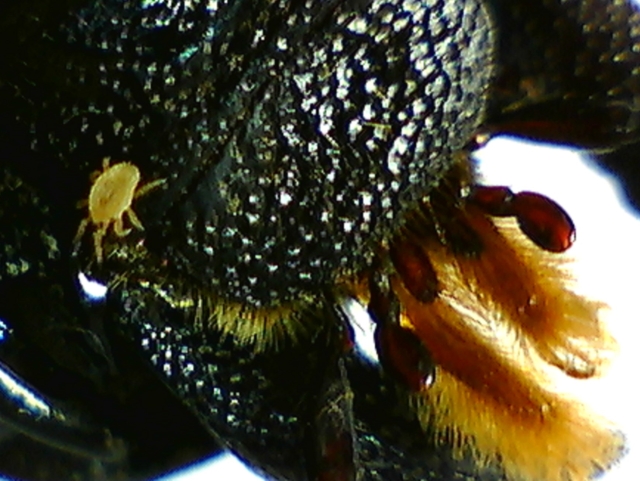Male stag beetle (L. cervus) with brown mites.
Photo by Maria Fremlin, Colchester, 10 June 2010.
Below is a rather scruffy male stag beetle which has quite a few mites on his antlers and one on the middle leg. Leg joints are a favourite spot for these mites.
Male stag beetle (L. cervus) with brown mites.
Photo by Maria Fremlin, Colchester, 10 June 2010.
Because mites are extremely small, highly diverse and specialised, there are very few people in the world who can identify them. Fortunately, some mite experts [*] were willing to help and we now know that these brown mites are probably phoretic deutonymphs of a Mesostigamatid “higher” uropodine mite (in the superfamily Uropodoidea). Deutonymphs are the second nymph or instar, in the life cycle of some Mesostigmatid mites. They moult into the adult and are not known to feed on the host.
Lesser stag beetles (Dorcus parallelipipedus) are a much longer lived beetle than stag beetles (L. cervus); they live 2-3 years mostly in the host wood together with their larvae. They carry mites much oftener too; sometimes a huge load of brown mites, typically underneath their bodies as illustrated below.
Female lesser stag beetle (D. parallelipipedus) with clusters of brown mites.
Photo by Maria Fremlin, Colchester, 2 July 2006.
Now let's have a closer look at the mites on the body of a female stag beetle (L. cervus) later on in the season. Females, after mating, lay their eggs in suitable places in the soil close to rotting wood; the males do not cooperate.
This female was found on top of a stump, was flaccid, rather worn out and slow, and she carried a few mites of a paler colour. She had probably picked them up while she laid her last eggs down below. In fact, she died three days later and strangely enough there were still quite a few mites on her body, some of which were rather mobile, see below.

Mite crawling on the body of a dead female stag beetle (L. cervus).
Photo by Maria Fremlin, Colchester, 11 July 2011.
Then, let's have a closer look at that stalk; it is called anal pedicle.

Two species of uropodine deutonymphs attached to stag beetles; they are facing in opposite directions. Photos by Maria Fremlin.
Lastly, the lesser stag beetle which had the above attached brown mite also had a cluster of a third species of mites, see below.

Cluster of rather mobile mites on male lesser stag beetle (D. parallelipipedus).
Photo by Maria Fremlin, Colchester, 4 August 2011.
Interestingly, this male lesser stag beetle is rather old. The above photo was taken 420 days after his first recapture and he was very lively. Indeed, the photos were rather tricky to take!
These mites are probably a member of a different order, the Astigmata.
Is this just a coincidence or do lesser stag beetles have a different mite fauna from stag beetles?
Probably, yes, because the adults spend most of their lives in their host wood whereas stag beetles spend it in the soil and have a much shorter life.
Passalids, who also spend most of their entire life in rotting wood, have a very diverse mite fauna. Owen Seeman collected 51 species of Mesostigamata mites from nine species of passalid beetle, some of which seem to be specific (Acarology: proceedings of the 10th International Congress - Page 275). But I'm not sure if there is anything known about their relationships.
However, there are some interesting, well studied, symbiotic associations of mites with burying and dung beetles. Their phoretic mites are supposed to alight and clear the beetles' breeding source (carrion or dung) of eggs from other competitors' eggs.
Dr. David E. Walker hopes that the project on the conservation of the European Stag Beetle is considering their mite fauna - they may need conserving too. And I entirely agree; just a quick glance has yielded three species, representing three families and two orders, and raised a few questions. There is a lot to discover!
Therefore I would like to know of anybody who is studying them or willing to do so.
Just contact Maria Fremlin!
Links:
Hitching a lift: stag beetles as carriers of mites by Colin Hawes, White Admiral, 2010, 77: 16-17, for a good description of the life cycle of uropodine mites identified by Dr. Anne Baker.
Glossary of Acarine Terms by Dr David E. Walker.
Macromite's Blog for a bit about phoresy.
Camel ticks
* Acknowledgements:
I'm very grateful to Prof. Barry M. OConnor and Dr. David E. Walker for their help with the identification of the mites on these photos. Also to Colin Hawes for asking me for some stag beetle mites and then sorting out their identification via Dr. Anne Baker.
Last modified: Thu Sep 29 07:29:17 BST 2011
| Main | Stag beetle life cycle | Lesser stag beetle life cycle | Return to the top |